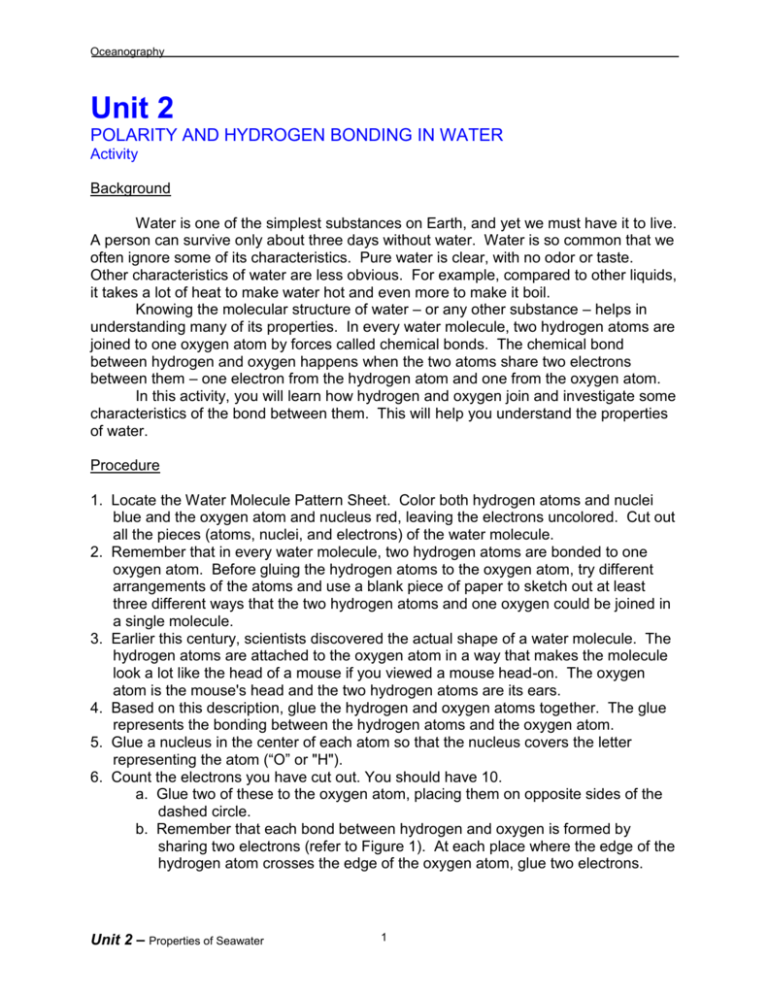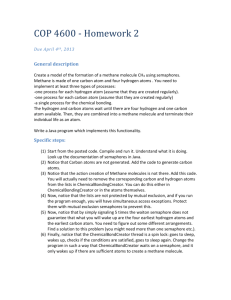Unit 1
advertisement

Oceanography Unit 2 POLARITY AND HYDROGEN BONDING IN WATER Activity Background Water is one of the simplest substances on Earth, and yet we must have it to live. A person can survive only about three days without water. Water is so common that we often ignore some of its characteristics. Pure water is clear, with no odor or taste. Other characteristics of water are less obvious. For example, compared to other liquids, it takes a lot of heat to make water hot and even more to make it boil. Knowing the molecular structure of water – or any other substance – helps in understanding many of its properties. In every water molecule, two hydrogen atoms are joined to one oxygen atom by forces called chemical bonds. The chemical bond between hydrogen and oxygen happens when the two atoms share two electrons between them – one electron from the hydrogen atom and one from the oxygen atom. In this activity, you will learn how hydrogen and oxygen join and investigate some characteristics of the bond between them. This will help you understand the properties of water. Procedure 1. Locate the Water Molecule Pattern Sheet. Color both hydrogen atoms and nuclei blue and the oxygen atom and nucleus red, leaving the electrons uncolored. Cut out all the pieces (atoms, nuclei, and electrons) of the water molecule. 2. Remember that in every water molecule, two hydrogen atoms are bonded to one oxygen atom. Before gluing the hydrogen atoms to the oxygen atom, try different arrangements of the atoms and use a blank piece of paper to sketch out at least three different ways that the two hydrogen atoms and one oxygen could be joined in a single molecule. 3. Earlier this century, scientists discovered the actual shape of a water molecule. The hydrogen atoms are attached to the oxygen atom in a way that makes the molecule look a lot like the head of a mouse if you viewed a mouse head-on. The oxygen atom is the mouse's head and the two hydrogen atoms are its ears. 4. Based on this description, glue the hydrogen and oxygen atoms together. The glue represents the bonding between the hydrogen atoms and the oxygen atom. 5. Glue a nucleus in the center of each atom so that the nucleus covers the letter representing the atom (“O” or "H"). 6. Count the electrons you have cut out. You should have 10. a. Glue two of these to the oxygen atom, placing them on opposite sides of the dashed circle. b. Remember that each bond between hydrogen and oxygen is formed by sharing two electrons (refer to Figure 1). At each place where the edge of the hydrogen atom crosses the edge of the oxygen atom, glue two electrons. Unit 2 – Properties of Seawater 1 Oceanography c. Glue the rest of the electrons (you should have four left) to the oxygen atom spacing them evenly around the solid outer circle. oxygen atom one electron from oxygen hydrogen atom one electron from hydrogen (Figure 1) 7. Because of the way hydrogen and oxygen bond, each hydrogen atom has a slightly positive charge, and the oxygen atom has a slightly negative charge. Draw a “-“ sign on the oxygen atom and a “+” sign on each hydrogen atom. Do you notice that the “+” signs are on one end of the molecule and the “-“ sign is on the other end? This roughly gives the molecule opposite charges on either end, similar to a bar magnet's north and south pole. Molecules with their “+” and “-“ charges arranged like this are called polar molecules. Water is considered a strongly polar molecule. Because water molecules are polar, they “stick” together much like magnets do (see questions 5 and 6). This sticking together is one reason why water requires so much heat to warm up and even more to boil. It is also responsible for some of water's other properties; for example, surface tension. Questions/Conclusions 1. Name the elements found in a water molecule. 2. What is the ratio of hydrogen atoms to oxygen atoms in a water molecule? 3. A molecule is a combination of atoms that are bonded together. How are the oxygen and hydrogen atoms of a water molecule held together? 4. Describe a polar molecule. 5. If one object has a positive charge and one has a negative charge, what will they tend to do to each other? (Hint: Have you ever heard the saying "Opposites attract"?) 6. Using your answer to question 5, why do you think water molecules tend to "stick" together? What are some different ways that two water molecules could be positioned so that they stick together? Unit 2 – Properties of Seawater 2 Oceanography Water Molecule Pattern Sheet Oxygen Nucleus 8 protons 8 neutrons Hydrogen Nucleus 1 proton Electrons Hydrogen Nucleus 1 proton Unit 2 – Properties of Seawater E E E E E E E E E E 3








